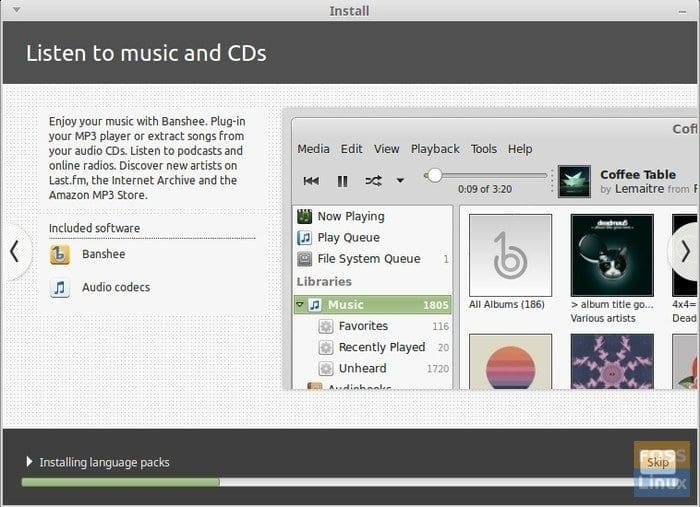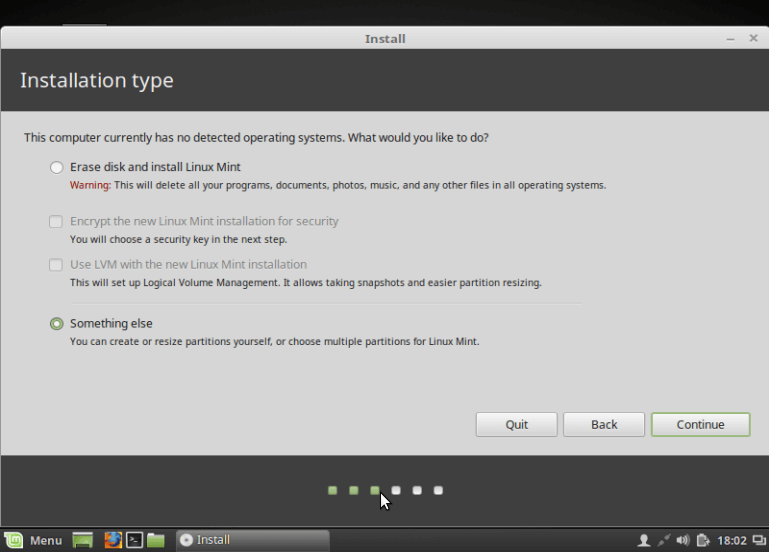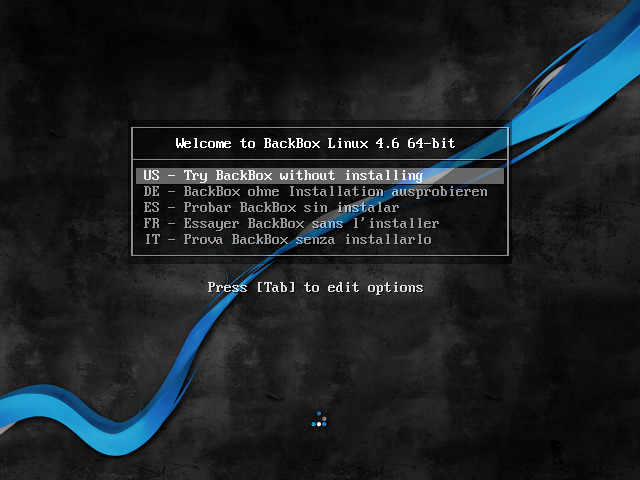Installer Linux Mint Sans Boot
Install Linux Mint VirtualBox - Click Restart Now Button. That's all there is to do and it is that simple to install Linux Mint in VirtualBox. If you are again booted into the ISO image, then remove the disk image the virtual machine settings (refer step 10). Install Linux Mint in VirtualBox - Installation Completed. Jul 11, 2016. At the time, I was having trouble getting the latest 64-bit Linux distro DVDs to boot. Eventually I came across ubuntu-14.04.3-desktop-amd64+mac.iso which actually did boot and install. Linuxmint-18.3-cinnamon-64bit-mac-mattgadient.com.iso ( md5: 843459df1674b73296ac0bc8f1b055fc ) – Linux Mint.
Linux Mint is based on Ubuntu Linux distribution. Linux Mint 19 codename Tara is based on Ubuntu 18.04 LTS. So all the software that is available on Ubuntu 18.04 LTS is also available on Linux Mint 19. Linux Mint 19 also has some extra softwares.Linux Mint 19 features a nice looking Cinnamon desktop environment. Linux Mint 19 also has images for MATE and XFCE desktop environment.
Beta version of Linux Mint 19 is available for download at the time of this writing. Stable version should be released at the end of June according to Linux Mint’s blog.
In this article, I will show you how to make a Linux Mint 19 bootable USB drive and install Linux Mint 19 from it. Let’s get started.
Downloading Linux Mint 19:
When the stable version of Linux Mint 19 will be released, you can download an image of Linux Mint 19 from https://linuxmint.com/download.php
Linux Mint 19 “Tara” Cinnamon BETA can be downloaded from https://blog.linuxmint.com/?p=3581
Linux Mint 19 “Tara” MATE BETA can be downloaded from https://blog.linuxmint.com/?p=3582
Linux Mint 19 “Tara” XFCE BETA can be downloaded from https://blog.linuxmint.com/?p=3583
I am going use Linux Mint 19 “Tara” Cinnamon BETA in this article.
Making Bootable USB Drive from Linux:
If you have a Linux distribution such as Ubuntu/Debian/Fedora etc installed on your computer, you can make a bootable USB drive of Linux Mint 19 “Tara” with the following command:
NOTE: Here /dev/sdb is the USB drive. You may have a different identifier. Make sure you check with sudo lsblk before you run this command.
Once the process is completed, you should be able to boot from the USB drive.
Making Bootable USB Drive from Windows:
From Windows, Rufus can be used to make a Linux Mint 19 bootable USB drive.
First go to the official website of Rufus at https://rufus.akeo.ie/ and you should see the following window.
Scroll down a little bit to the Download section and click on Rufus Portable link as marked in the screenshot below.
Rufus Portable should be downloaded.
Now run Rufus Portable.

Click on No.
Rufus Portable should start.
Now insert your USB drive. Rufus should detect and select it as you can see from the marked section of the screenshot below.
Now click on Select.

A file picker should be opened. Select your Linux Mint 19 iso file you just downloaded and click on Open.
It should be selected. Now click on START as marked in the screenshot below.
Click on YES.
If you don’t know what it is, just leave the default and click on OK.
All the data of your USB drive should be erased. If you don’t have anything important on your USB drive, click on OK. Otherwise, make a backup of your data and try again.
It should take a while for the process to complete.
Once it’s completed, you can click on CLOSE.
You USB drive is now ready.
Booting from the USB Drive:
Now that you have a bootable USB drive of Linux Mint 19, you can boot from it and install Linux Mint 19 on your computer. First insert your USB drive to your computer. Now you have to select your USB drive from the BIOS of your computer. Usually you press F2 or Delete or some other keys just after you pressed the power button of your computer. It depends on the motherboard of your computer. Please check the manual of your Motherboard for more information.
Once you select your USB drive from the BIOS, you should see the following window. Select Start Linux Mint 19 Cinnamon 64-bit and press <Enter>.
You should be booted into the Linux Mint 19 Cinnamon Live DVD.
Installing Linux Mint 19:
Boot Linux Mint From Dvd
In this section, I will show you how to install Linux Mint 19 on your computer.
First double click on Install Linux Mint icon as marked in the screenshot below.
The Linux Mint 19 installer should start. Select your language and click on Continue.
Now select your Keyboard layout and click on Continue.
If you want to install third party drivers and multimedia codecs while installing Linux Mint 19, mark the Install third-party software for graphics and Wi-Fi hardware, Flash, MP3 and other media as marked in the screenshot below. You will need internet connectivity for that. Once you’re done, click on Continue.
If you want to erase everything and install Linux Mint 19 on your hard drive, the easiest option is Erase disk and install Linux Mint.
But if you want to dual boot Windows and Linux, then you will have to select Something else. In this case you can do manual partitioning and install Linux Mint 19 on custom partitions. That’s what I am going to show you in this article.
You may not have a partition table on your hard drive. Just select your hard drive and click on New Partition Table…
Now click on Continue.
For UEFI installation, you need an EFI System partition and a Root(/) partition. For BIOS installation, you only need a Root(/) partition. I am going for the UEFI installation.
To create a new partition, select free space, and click on the + button.
On the Create partition window, make sure the following options are selected. Once you’re done, click on OK. EFI System Partition should be 512 MB in size.
Now create a Root(/) partition with the rest of the free space. Make sure the Mount point is set to /. Once you’re done, click on OK.
Now make sure the correct Device for boot loader installation is selected and then click on Install Now.
Click on Continue.
You may see this warning, just click on Continue.
Now select your location and click on Continue.
Now fill in your personal details and click on Continue.
The installation should start.
Once the installation is complete, click on Restart Now.
Your computer should restart and once it starts you should be booted into your newly installed Linux Mint 19 operating system.
Installer Linux Mint Sans Boots
Linux Mint 19 Cinnamon Desktop Environment:
That’s how you make bootable USB drive of Linux Mint 19 and install Linux Mint 19 from the USB drive. Thanks for reading this article.
Linux Mint Installer Usb
For those of you with no cd drive (or disks) and no spare usb stick. Installing Linux Mint can be a battle. This tutorial aims to make it easy and painless to install Mint to any pc, even if all you have is a hard disk that is owned by windows.
Requirements
ISO of your desired mint edition (e.g. mint 9 main)

recommended minimum 1Gb Ram
Step 1 - Editing partitions
First, some background on partitions. A Hard disk may be split into partitions. each one acts like its own individual hard disk. Each operating system you install requires a partition. So far so simple. The problem is that windows will probably already have used the whole disk for its partition, and partitions (normally) can't be resized when they're in use. Unetbootin, however, can cheat and have two operating systems on one partition. How it does this is beyond the scope of this tutorial, it's enough to know that it is functional but not an optimal way of doing things.
Run the unetbootin installer. choose your parted magic iso and choose frugal install. Install it to your windows partition (normally C:) when it tells you it's done you can reboot. When you reboot into your unetbootin installation you should be able to choose to load Parted Magic entirely into RAM. This means that, once running, it will not actually be using the hard disk at all - leaving you free to resize the partitions.
Once Parted Magic has booted, select the gparted application. It's fairly easy to use. simply select your windows partition, click edit, and shrink it by about 8Gb. Make sure you leave the empty space to the right of the partition (yes it is important). Then click apply.
Step 2 - Installing the system
Reboot into Windows. Unetbootin may prompt you to remove the installation. If not running the unetbootin installer again should remove it. (If neither happens then control panel and add/remove programs on XP or Programs and features on vista/7 and remove it there).
Run the Unetbootin installer again and this time, select your linux mint iso to use for the frugal install. Reboot into this new installation.
Once in mint, run gparted (yes again). In the spare space create a new partition, and format it as ext4 (often you'll be told to create a swap partition; you can if you want; I don't normally; google will tell you more). Click the install icon on the desktop. When it gets to partitioning, click specify manually. Choose your new partition and pick use as: ext4, mount point: /
Let the installer do its job. now you have a choice. Left like this the system will allow you to dual-boot (i.e. choose between linux and Windows when yu switch on the pc). However, you may want to get rid of windows completely. Which leads to...
Step 3 - Removing Windows
Reboot to Windows. Remove Unetbootin (you'll want to do this even if you're dual-booting). Reinstall Parted Magic as we did in step 1. Reboot to parted magic (loading it to RAM again).
Open up gparted (isn't it useful). First, delete the Windows partitions. Then (and this is very important), move the linux partition to the left, then grow it to the right. Do not try to grow it to the left. (This is the time to create your swap partition if you want one). Reboot
Finally, you may notice that when you reboot you still have an entry for windows in your menu. This can be fixed by reinstalling grub when you get to your linux installation. (by going to the terminal and typing: sudo apt-get reinstall grub-pc).
Note: Although this tutorial deals specifically with Mint and Parted Magic, it is possible to apply the same idea to any combination of distros, provided that the one you use to replace parted magic can load to ram and has a partitioning tool on it.